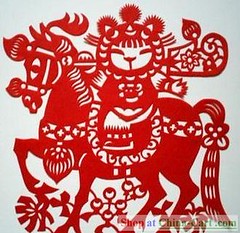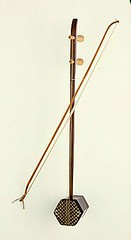| Home > Living in China > Art |
Local Styles of Paper-cuts in China
 |
|
Daisy |
 Though making of paper-cut is simple, its content is rich and reveals many local Chinese customs. Patterns of moppets, gourd vessels and lotus flowers symbolize numerous offspring; festival and peaceful patterns can help avoid evil spirits; patterns of domestic birds, livestock, fruits, fish and worms are closely linked with people's lives. Moreover, Chinese paper-cuts are strongly influenced by regional elements. For example, Shaanxi window paper-cuts appears simple, bold and unconstrained; Hebei and Shanxi paper-cuts are graceful and colorful; while Yixing paper-cuts of Jiangxi Province feel magnificent and neat.
Though making of paper-cut is simple, its content is rich and reveals many local Chinese customs. Patterns of moppets, gourd vessels and lotus flowers symbolize numerous offspring; festival and peaceful patterns can help avoid evil spirits; patterns of domestic birds, livestock, fruits, fish and worms are closely linked with people's lives. Moreover, Chinese paper-cuts are strongly influenced by regional elements. For example, Shaanxi window paper-cuts appears simple, bold and unconstrained; Hebei and Shanxi paper-cuts are graceful and colorful; while Yixing paper-cuts of Jiangxi Province feel magnificent and neat.Fengning Manchu Nationality paper-cuts - Fengning in Hebei Province was reputed as 'Home of Folk Paper-cuts in China' by Ministry of Culture. In content, they include festival paper-cuts, fruit paper-cuts, animal paper-cuts, character paper-cuts and paper-cuts of flowers, birds, fish, worms, landscape, scenery, persons, baskets, basins, dishes and bottles.
Yangzhou paper-cuts - one of the earliest areas doing regional paper-cutting in China. The people in Yangzhou also cut paper money, horses and other funeral objects to sacrifice to their ancestors. Yangzhou paper-cuts are clear and fluent of their lines, fine and elegant of their patterns and seeking freshness in a change of techniques.
Dai Nationality paper-cuts - popular in Dehong Daizu jingpozu Zizhizhou of Luxi City, Yunnan Province, it originated from the paper streamers used for sacrifices of the Dai people. Later, it was widely used in funerals, festivals, house decorations or making sacrifices to the ancestors and Buddha. Most of the paper-cuts there are relevant to the Buddhism.
Ansai paper-cuts ?on the festival days, women of Ansai County, Shaanxi Province, will cut paper-cuts and paste then on the windows. Ansai paper-cuts are beautiful in shape, fine in cutting skills and profound of history and culture. They are recognized as cultural treasures and the 'living fossils' of the culture.
Art
 more
moreLocal Styles of Paper-cuts in China
Daisy Though making of paper-cut is simple, its

Origin and Development of
Chinese paper-cuts As one of the most popular folk

History and Classification of
Erhu One of the most important aspects of Chinese

Customs
 more
more



 print
print  email
email  Favorite
Favorite  Transtlate
Transtlate 
